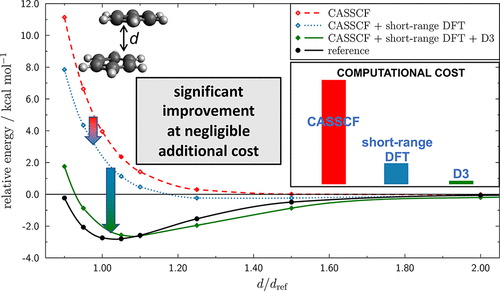当前位置:
X-MOL 学术
›
J. Phys. Chem. A
›
论文详情
Our official English website, www.x-mol.net, welcomes your
feedback! (Note: you will need to create a separate account there.)
Semiclassical Dispersion Corrections Efficiently Improve Multiconfigurational Theory with Short-Range Density-Functional Dynamic Correlation
The Journal of Physical Chemistry A ( IF 2.7 ) Pub Date : 2020-03-30 , DOI: 10.1021/acs.jpca.0c02130 Christopher J. Stein 1 , Markus Reiher 1
The Journal of Physical Chemistry A ( IF 2.7 ) Pub Date : 2020-03-30 , DOI: 10.1021/acs.jpca.0c02130 Christopher J. Stein 1 , Markus Reiher 1
Affiliation

|
Multiconfigurational wave functions are known to describe the electronic structure across a Born–Oppenheimer surface qualitatively correct. However, for quantitative reaction energies, dynamic correlation originating from the many configurations involving excitations out of the restricted orbital space, the active space, must be considered. Standard procedures involve approximations that eventually limit the ultimate accuracy achievable (most prominently, multireference perturbation theory). At the same time, the computational cost increases dramatically due to the necessity to obtain higher-order reduced density matrices. It is this disproportion that leads us here to propose an MC-srDFT-D hybrid approach of semiclassical dispersion (D) corrections to cover long-range dynamic correlation in a multiconfigurational (MC) wave function theory, which includes short-range (sr) dynamic correlation by density functional theory (DFT) without double counting. We demonstrate that the reliability of this approach is very good (at negligible cost), especially when considering that standard second-order multireference perturbation theory usually overestimates dispersion interactions.
中文翻译:

半经典色散校正可有效改善短距离密度函数动态相关的多构型理论
众所周知,多配置波函数可以描述在Born–Oppenheimer表面上定性正确的电子结构。但是,对于定量反应能量,必须考虑源自许多结构的动态相关性,这些结构涉及从受限轨道空间(活动空间)之外的激发。标准程序涉及近似值,这些近似值最终会限制可达到的最终精度(最著名的是多参考摄动理论)。同时,由于需要获得高阶缩减密度矩阵,计算成本急剧增加。正是这种歧义导致我们在这里提出一种半经典色散(D)校正的MC-srDFT-D混合方法,以涵盖多配置(MC)波函数理论中的远程动态相关性,其中包括通过密度泛函理论(DFT)进行的短距离(sr)动态相关,无需重复计算。我们证明了这种方法的可靠性非常好(成本可以忽略不计),尤其是考虑到标准的二阶多参考扰动理论通常会高估色散相互作用时。
更新日期:2020-03-30
中文翻译:

半经典色散校正可有效改善短距离密度函数动态相关的多构型理论
众所周知,多配置波函数可以描述在Born–Oppenheimer表面上定性正确的电子结构。但是,对于定量反应能量,必须考虑源自许多结构的动态相关性,这些结构涉及从受限轨道空间(活动空间)之外的激发。标准程序涉及近似值,这些近似值最终会限制可达到的最终精度(最著名的是多参考摄动理论)。同时,由于需要获得高阶缩减密度矩阵,计算成本急剧增加。正是这种歧义导致我们在这里提出一种半经典色散(D)校正的MC-srDFT-D混合方法,以涵盖多配置(MC)波函数理论中的远程动态相关性,其中包括通过密度泛函理论(DFT)进行的短距离(sr)动态相关,无需重复计算。我们证明了这种方法的可靠性非常好(成本可以忽略不计),尤其是考虑到标准的二阶多参考扰动理论通常会高估色散相互作用时。











































 京公网安备 11010802027423号
京公网安备 11010802027423号